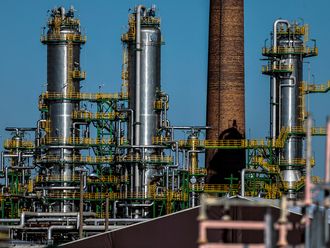An array of factors indicate that Indian shares are on course to outperform their peers across Asia and other emerging markets, but quarterly earnings that begin to roll out from the coming week could prove decisive on some trading days.
A cut in interest rates by the central bank, good monsoon rains across the country, higher pay packets for government employees and improving manufacturing activity are expected to provide strong impetus to the upbeat market mood in the run up to the biggest festival, when consumer demand peaks in India.
Investors, led by global funds, are bullish. They expect double-digit returns from stocks as the economy picks up steam. Bountiful showers after two successive years of deficient rainfall have boosted the prospects for agriculture, the mainstay for the bulk of the nation’s 1.2 billion people. Higher incomes in rural heartlands are crucial for industrial goods sales in India.
“Monsoon rainfall coming in at normal levels bodes well for agriculture and, along with a decennial rise in government employee salaries, will underpin the ongoing recovery in domestic demand,” the International Monetary Fund said in a report.
“Medium-term growth has also been revised upward reflecting continued progress on structural reforms (constitutional amendment enabling implementation of the national goods and services tax, adoption of inflation targets, and removal of foreign direct investment ceilings).”
With more money in their wallets people are stepping up spending, particularly on cars, motorcycles, housing and electronic goods. Sales of passenger vehicles grew 19.9 per cent in September, while demand for two-wheelers jumped 21.6 per cent. Annual bonuses for industrial workers and others are paid ahead of Diwali, the festival of lights, which falls on October 29, and should further fuel demand.
“The icing on the cake was the unexpected rate cut,” said equity salesman Manish Shah. “It has provided added glitter to the upcoming festivals. Expect a bonanza for producers of consumer goods.”
Lower borrowing costs
A new six-member Monetary Policy Committee (MPC) in its maiden decision unanimously recommended a rate reduction on Tuesday. Urjit Patel, who took over as the Reserve Bank of India (RBI) Governor in early September from acclaimed economist Raghuram Rajan, kicked off his first policy by lowering the repo rate to a six-year low of 6.25 per cent.
“The decision of the MPC is consistent with an accommodative stance of monetary policy in consonance with the objective of achieving consumer price index inflation at 5 per cent by Q4 of 2016-17,” the RBI said in a statement.
It was the first rate cut since April and Rajan had steadfastly stood his ground at subsequent policy reviews, warning about inflation pressures. Consumer price inflation eased to a five-month low of 5.05 per cent in August, within the 2-6 per cent MPC’s target and there is a strong likelihood of food prices coming off the boil on the back of higher farm output.
Securities houses and banks such as Nomura, ICICI Bank and Capital Economics say the repo rate could further drop to 6 per cent by next March if not earlier, while Morgan Stanley predicts it could fall as low as 5.75 per cent by the end of the financial year.
Lower rates would fit with New Delhi’s push for growth, but there are lingering doubts whether the underpinnings of inflation have been sufficiently doused. There is a possibility of price pressures building up, especially when the Goods and Services Tax becomes effective next April and could likely lead to increased costs of some products.
“The RBI has shifted from a one man rock star to more like a choir with ensemble of singers,” Sean Yokota, Singapore-based head of strategy at SEB AB, wrote in a report. “Patel’s style and new MPC framework are expected to be an improvement with more transparency but when inflation pressures rise, they may have a more difficult time standing tall to a pro-growth government.”
TCS, Infosys
Corporate results are expected to be mixed, with export-driven software services companies battling headwinds in their major markets such as the US and Europe. Infrastructure-related companies such as cement, steel, construction and engineering, automobile makers, consumer goods producers and pharmaceuticals should do well.
Tata Consultancy Services, the country’s top information technology company, is scheduled to release its September quarter results on Thursday, followed by the No. 2 firm in the sector Infosys Ltd the next day. Both companies have warned about slowing decision-making by their clients, which would affect the momentum of growth in revenue and profits.
“There is a likelihood that the business scenario for the whole IT industry is under pressure and is likely to remain under pressure,” Kunj Bansal, executive director and chief investment officer at Centrum Wealth Management, told ET Now television channel.
“While a lot of large-cap and midcap companies have already revised their top-line or bottom-line guidance, there is nothing to stop them from revising further downwards in the coming quarters. I do not think that it is yet time to do bottom fishing in the IT industry as a whole.”
Pankaj Pandey, research head at ICICIdirect.com, forecast revenue growth of nine per cent for the sector, with hardly any profit rise. More than the earnings numbers, fund managers and analysts would be watching for comments on the outlook, especially by Infosys which gives guidance on the quarters ahead and the full-year.
IndusInd Bank, controlled by the billionaire Hinduja family, is scheduled to unveil its earnings on Monday.
Foreigners upbeat
Profit-taking on the last three days pared gains, but benchmark indices still posted their best weekly rise in a month. The top-30 Sensex gained 0.7 per cent to 28,061.14 and the broader 50-share Nifty climbed one per cent to 8,697.60.
The market was underpinned by voracious appetite from foreign funds, which moved $245 million to domestic stocks over the week, adding to the $1.4 billion they bought in September. Overseas funds have pumped a net $7.8 billion into domestic stocks so far this year, more than double the inflow in the whole of 2015.
Tata Steel, which produces the bulk of output at its Europe-based Corus unit, rallied 8.6 per cent over the week to Rs. 406.40, its highest close since January 2015, bolstered in part by high tariffs imposed by the European Union on two types of steel from China.
Shares in Tata Motors rose 5.8 per cent over the week to Rs. 565.70 after the company said sales of its marquee brands Jaguar and Land Rover jumped 28 per cent in September. Auto parts maker Bharat Forge climbed 4.9 per cent to Rs. 956.55 after brokerage CLSA raised the stock to “buy” from “sell”.
Among losers were software services companies. Tata Consultancy Services dropped 2.4 per cent and Infosys shed 2.5 per cent.
The author is a journalist based in India.












